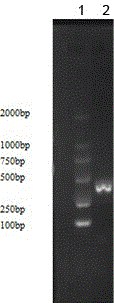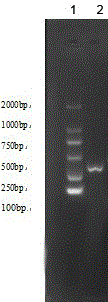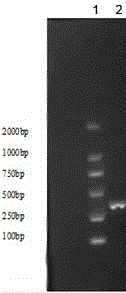Kit and method for staphylococcus aureus CRISPR locus detection
A detection kit and staphylococcus technology, applied in the field of microbial detection, can solve the problems of no specific detection, etc., achieve the effect of low detection cost, high sensitivity and specificity, and good promotion and application value
- Summary
- Abstract
- Description
- Claims
- Application Information
AI Technical Summary
Problems solved by technology
Method used
Image
Examples
Embodiment 1
[0044] There are three types of CRISPR locus gene sequences in Staphylococcus aureus, namely CRISPR-1, CRISPR-2 and CRISPR-3. Three primers for CRISPR loci were designed based on the published CRISPR-related gene sequences of Staphylococcus aureus in Genebank:
[0045] CRISPR-1 upstream primer 5’-GTAGTGATTTTTGGGAGTGG-3’,
[0046] Downstream primer 5'-GTGGTTAATGTGTAGGGACC-3',
[0047] CRISPR-2 upstream primer 5’-CAATGACTTGGAGTGTGA-3’,
[0048] Downstream primer 5'-GGTTAATGTGTAGGAACC-3',
[0049] CRISPR-3 upstream primer 5’-ACTCAATGGCATGGAGTGTGA-3’,
[0050] Downstream primer 5'-GGTGGTTAATGTGTAGGGACC-3'.
[0051] Staphylococcus aureus CRISPR locus detection kit includes primers designed for the CRISPR locus gene sequence of Staphylococcus aureus, 10×Tag Buffer, 0.2 mM dNTP, 2 mM MgCl 2 , 0.05U / μL Tag DNA polymerase, sterilized ultrapure water and DNA Marker 2000.
Embodiment 2
[0053] The detection method of Staphylococcus aureus CRISPR site, comprises the following steps:
[0054] (1) Genomic DNA of bacterial samples was extracted by boiling method.
[0055] (2) Using the genomic DNA of the bacterial sample as a template, PCR amplification was performed using primers of three kinds of CRISPR locus gene sequences respectively. The primer sequences are as shown in Example 1. The reaction system of the PCR amplification is: 10 μmol / L 1 μL of upstream primer, 1 μL of 10 μmol / L downstream primer, 2.5 μL of 10×Tag Buffer, 0.5 μL of 0.2 mM dNTP, 2 mM MgCl 2 2 μl, 0.125 μL of 0.05U / μL Taq DNA polymerase, 2 μL of bacterial sample genomic DNA, 15.875 μL of sterilized ultrapure water. The PCR amplification reaction procedures adopted for different CRISPR site gene sequences are as follows:
[0056] CRISPR-1 pre-denaturation at 94°C for 5 minutes; denaturation at 94°C for 30s, annealing at 51°C for 30s, extension at 72°C for 30s, a total of 35 cycles, and ex...
experiment example
[0062] 1. Sample collection
[0063] The bacterial sample used in the test was Staphylococcus aureus, which was isolated in a hospital in Zhengzhou, Henan in 2014.
[0064] 2. Experimental method
[0065] Using the detection kit of the present invention to detect the CRISPR site of the bacterial sample, the detection steps are as follows:
[0066] (1) Preparation of DNA template
[0067] Whole genomic DNA was extracted from bacterial samples using the boiling method. Take out the bacterial sample cryopreservation tube from the -80°C refrigerator, put it in a 4°C refrigerator for rewarming for 5 hours, use a sterile inoculation loop to quickly dip the bacterial solution in the ultra-clean bench, and inoculate it on Columbia blood agar culture by segmented streaking method On the plate, incubate for 20 hours in a 37°C incubator, pick a single colony on the blood plate, inoculate it in the brain heart infusion liquid medium, culture it with shaking at 37°C for 16 hours, take 1...
PUM
 Login to View More
Login to View More Abstract
Description
Claims
Application Information
 Login to View More
Login to View More - R&D
- Intellectual Property
- Life Sciences
- Materials
- Tech Scout
- Unparalleled Data Quality
- Higher Quality Content
- 60% Fewer Hallucinations
Browse by: Latest US Patents, China's latest patents, Technical Efficacy Thesaurus, Application Domain, Technology Topic, Popular Technical Reports.
© 2025 PatSnap. All rights reserved.Legal|Privacy policy|Modern Slavery Act Transparency Statement|Sitemap|About US| Contact US: help@patsnap.com



